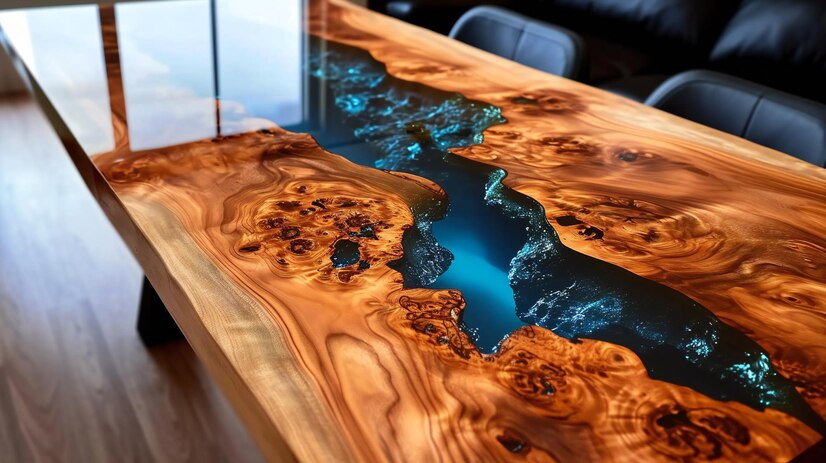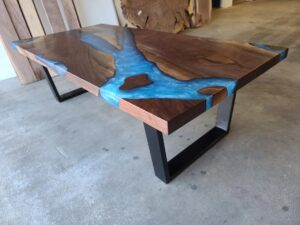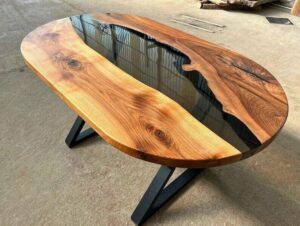Resin tables are transforming homes in the UK with their unique aesthetic and durable designs. From creating a polished, professional poly resin coffee table to crafting a custom resin dining table and chairs, the versatility of resin is making waves in home décor. Resin tables allow you to incorporate personal elements, like coins or flowers, into a beautiful finish that suits a range of styles – from rustic resin and wood tables to modern periodic table resin blocks. In this guide, we’ll walk you through the essentials of pouring and polishing resin, helping you create a stunning table that will serve as a centrepiece in any room.
An Overview of Resin Tables Types and Trends
Resin tables come in countless forms, each one unique. Whether you’re looking for a resin and wood dining table to elevate your dining area or a resin coffee table with storage to add functionality to your living room, resin furniture offers style and durability. Popular in the UK, resin tables like the pink epoxy resin table or the earthy pine resin table reflect personal taste and creativity. You can make your resin coffee table DIY project or find the perfect resin and wood dining table UK to add to your space. Understanding resin types, resin table accessories, and styles will help you choose the right piece or project.
Types of Resin for Tables
Selecting the right resin for your table project depends on factors like durability, clarity, and specific needs.
Epoxy Resin
Epoxy resin is a top choice for DIY projects like resin coffee tables or specialized designs like resin koi pond tables and resin lake tables. Known for its clarity and strength, epoxy is ideal for creating unique resin inlay tables with embedded objects, such as Pokemon card resin tables or periodic tables in resin projects.
Polyester Resin
Polyester resin is ideal for outdoor furniture, such as plastic resin patio tables and resin garden tables, due to its durability and affordability. It’s an excellent option for larger projects, such as resin dining tables or resin BBQ tables. However, it can turn yellow over time when exposed to sunlight.
Poly Resin
Lightweight and easy to use, polyresin is perfect for small furniture like poly resin coffee tables, resin bedside tables, and even decorative items like a resin flower coffee table. It’s also commonly used for resin bottle cap tables and resin candy tables.
Selecting a Base Material
The material you use as a base for your resin table affects its appearance, weight, and durability. Each material brings unique qualities, making it essential to choose the right one for your project.
Wood
Wood is a popular choice for its versatility and natural beauty. Projects like resin and wood side tables, resin live edge tables, and resin-filled wood tables use wood as the primary structure, giving a rustic and earthy look that balances well with the high-gloss finish of resin.
Concrete
For an industrial aesthetic, concrete is a durable choice, as seen in resin and concrete tables. This material is particularly effective for outdoor tables, such as a resin garden table or a resin patio table.
Stone and Timber
For tables that need a more rugged look, stone and timber bases work beautifully with resin. Combining resin with elements like stone or timber in pieces such as resin and stone tables or resin timber tables adds character and natural touch.
Preparing Your Resin Table Surface
Once you’ve selected your materials, prepare the surface to ensure a smooth and even pour. This step is essential whether you’re working on a resin hall table or an elaborate resin koi table.
Sanding and Cleaning the Surface
Start by sanding the surface to create an even, smooth base. Use fine-grit sandpaper for sensitive surfaces like reclaimed wood in a resin-filled wood table and coarse-grit for tougher materials like stone or concrete. Wipe away dust and debris with a damp cloth and allow the surface to dry before pouring.
Adding Decorative Elements
Resin tables offer the opportunity to embed unique objects within the tabletop, creating visually appealing designs. You can incorporate elements such as bottle caps, creating a resin beer cap table or a resin bottle top table. If you’re interested in creating a more educational piece, try a periodic table of elements resin where each square showcases an element.
Step-by-Step Guide to Pouring Resin for a TableTop
Pouring resin is an exciting yet delicate process. Follow these steps to achieve a professional finish, even if it’s your first time.
Mixing the Resin
Start by mixing your resin carefully according to the manufacturer’s instructions. Proper mixing is essential to avoid issues like clouding and bubbles, especially in large pieces like a resin conference table or resin dining table for sale.
Pouring Techniques for Layered and Clear Finishes
If you’re working on a large project like a resin island table, consider pouring the resin in layers to prevent overheating and create depth. For tables with decorative elements, such as a resin chess table or resin anchor load tables, pour the resin over the objects gradually, allowing each layer to settle.
Eliminating Bubbles
Bubbles are common when pouring resin. For a flawless finish, gently pass a heat gun or torch over the surface to release the trapped air. This technique is especially useful for maintaining clarity in resin crystal tables or a high-gloss resin coffee bean table.
Polishing Resin Tables: Achieving a Mirror-Like Shine
Polishing is the final step in creating a resin table with a glassy, professional finish. Polishing resin requires patience, but the results are worth the effort, particularly for pieces like resin art dining tables or resin floral tables.
Choosing the Right Polish and Tools
Choose a polish designed for resin, especially if you’re polishing a table intended for heavy use, like a resin bar table or resin camping table. Using a buffing machine and polishing pads will help you achieve a mirror-like finish on pieces like resin art table tops or resin epoxy coffee tables.
Polishing Techniques for Different Tables
Start by wet sanding with increasingly finer grits, moving from coarse to fine to achieve an ultra-smooth surface. Finish by buffing with a polishing compound to add a high gloss. This technique works well for tables of all sizes, from smaller resin bedside tables to larger resin console tables.
Safety Tips for Polishing Resin
Always work in a well-ventilated area, wear gloves, and use a mask to avoid inhaling fumes. Polishing can be messy, so consider laying down protective sheets if working on a larger piece like a resin gaming table or a resin dining table round.
Maintaining Resin Tables for Longevity and Shine
To keep your resin table looking new, establish a regular maintenance routine. Proper care is essential for high-use pieces, whether you have a resin beach table or an epoxy resin dining table.
Cleaning Tips for Resin Tables
Use a gentle cleanser and a soft cloth to wipe down your table. Harsh chemicals and abrasive sponges can scratch the surface, particularly on clear designs like a resin geode coffee table or resin fish table.
Routine Polishing and UV Protection
For tables exposed to sunlight, like resin garden tables, periodic polishing and UV-protective sprays can prevent yellowing and maintain shine. Polishing every few months will also help keep your table in excellent condition, whether it’s a resin end table or a resin coffee table outdoors.
Popular Resin Table Styles and Trends
Resin tables have become popular for their versatility and beauty. Here are some trending designs in the UK:
Embedded Art and Decorative Pieces
Adding embedded art is a fantastic way to personalize your table. You might choose a resin coin table, a resin beer bottle cap table, or even a resin floral table to add unique touches to your home. Another popular choice in the UK is the resin chess table, which is ideal for game enthusiasts.
Natural and Rustic Aesthetic
Rustic, natural elements are trending, with designs like the resin and timber table, pinecone resin table, and reclaimed wood resin table making their way into homes. The contrast between natural materials and glossy resin creates a rustic charm that works well in both contemporary and classic interiors.
Colourful and Statement Pieces
Vibrant, colourful designs are popular choices for UK homeowners looking to add a splash of colour to their décor. Consider a pink epoxy resin table, a red resin coffee table, or even a multi-coloured rainbow resin table for an eye-catching statement piece.
Versatile Outdoor Resin Furniture
Resin tables are great for outdoor use, too. Options like resin camping tables, plastic resin patio tables, and resin BBQ tables offer durability in various weather conditions. For a stylish garden addition, consider a resin bird table or resin bistro table and chairs.
Conclusion
Creating a resin table is a rewarding project that combines artistry with functionality. Whether you’re looking to make a resin geode table or a practical resin kitchen table, resin allows you to express your creativity while making a lasting piece. From the vibrant purple resin table to the classic resin and wood dining table, resin furniture offers versatility that suits every taste and room. With the right tools, techniques, and a bit of patience, you’ll have a unique table that not only reflects your style but also stands the test of time. Embrace the beauty of resin and add a stunning masterpiece to your UK home.
FAQS
Epoxy resin is the best choice for durable table tops due to its excellent clarity and scratch resistance. It offers a longer curing time, allowing for flexibility during pouring. Although more expensive, its high-quality finish makes it worthwhile for functional furniture.
To remove bubbles, use a heat gun or torch and gently pass it over the resin’s surface immediately after pouring. The heat releases trapped air, causing bubbles to rise and pop, resulting in a smooth finish. Avoid overheating, as this may damage the resin or cause yellowing.
Yes, resin tables can be used outdoors, especially when made with UV-resistant polyester resin to prevent yellowing. Applying a clear topcoat designed for outdoor use enhances protection against the elements. Regular maintenance, like covering the table during harsh weather, keeps it looking new.
olish your resin table every few months to maintain its glossy finish and protect against scratches. Use a soft cloth and a resin-specific polish, applying it evenly in circular motions. Regular cleaning with mild soap and water will also help keep it free from dust and stains.




